Texas Railroad History - Tower 58 - Alvarado
A Crossing of the Gulf, Colorado & Santa Fe Railway and the
Missouri - Kansas - Texas Railroad
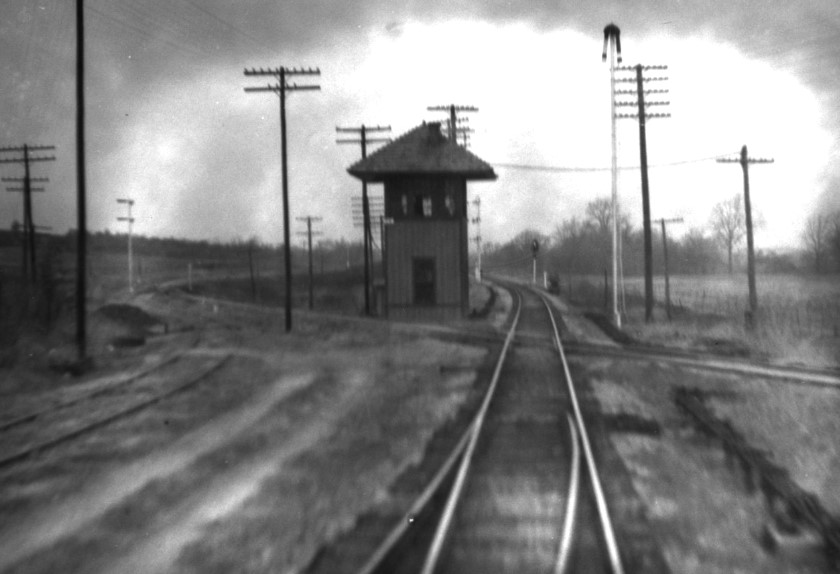
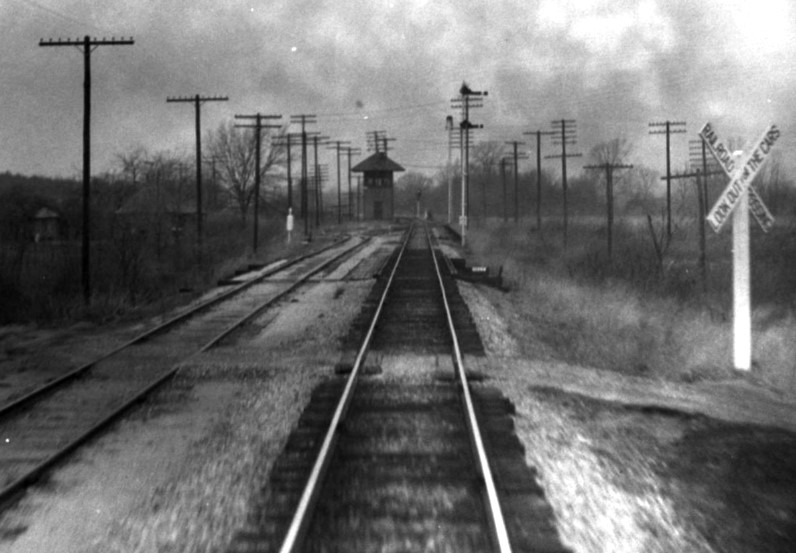
These two photos were shot sequentially from the rear
platform of John W Barriger III's business car,
probably in the late 1930's or early 1940's. The view of Tower 58 is looking
northwest along the Missouri - Kansas - Texas (MKT, "Katy") Railroad as
Barriger's train was headed south toward Waco. In the photo
above left, the Gulf, Colorado
& Santa Fe (GC&SF) tracks cross at an angle in the foreground. To the left of
the tower, the Santa Fe curves back to the northwest beside the Katy. Note the exchange
track at far left which came off the Santa Fe near the tower and paralleled the
Katy to the south. Barriger is directly above the switch for a short connecting track
that went to his left and merged into the exchange track. At the far south end,
the exchange track merged into the Katy. This provided maximum switching
flexibility for the Katy, allowing trains in either direction to move cars on or
off the exchange track easily. Above right,
Barriger's photo taken a few seconds later shows a better view of the exchange track. The short connecting track is visible in the distance where the
exchange track begins its curve to the left to join the Santa Fe.
Below: This photo of Tower 58 was taken by Barriger on a different trip, this time looking
south down the Katy, with the Santa Fe track crossing behind the tower. The
switch to the exchange track is visible just beyond the crossing diamond.
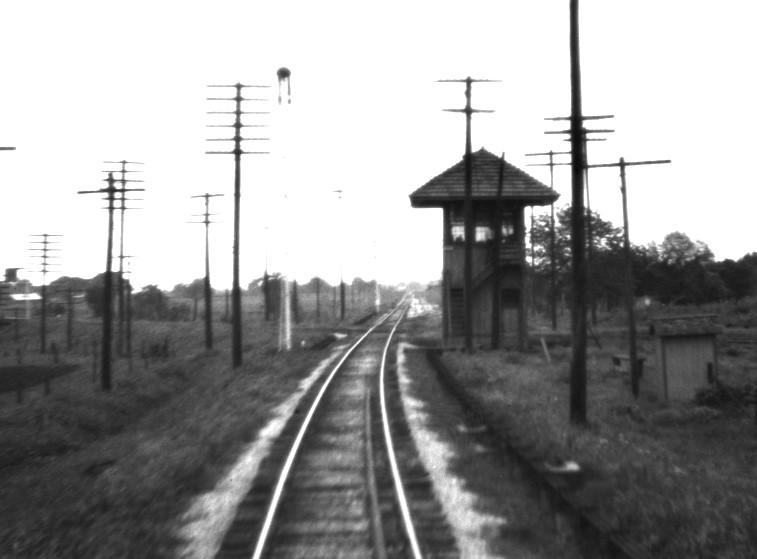
 |
Left:
This excerpt from a 1945 Santa Fe employee timetable describes the
semaphore signals controlling access to the exchange track.
Right: The semaphores
are visible in the first Barriger photo above. |
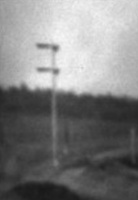 |
Alvarado, reportedly named by the local sheriff for a
town in Mexico, has existed since the early 1850s, pre-dating the arrival of the
railroads by thirty years. The town did not incorporate until 1878 when plans for
railroads through the vicinity were being promoted by various interests. As
early as the chartering of the Dallas & Cleburne Railroad in 1876, locals began
to anticipate rail service, but it did not materialize until July 26, 1881.
Technically, the first tracks into Alvarado were owned by the Missouri - Kansas
- Texas ("Katy") Railroad coming south out of Fort Worth,
but the Katy was under
lease to the Missouri Pacific (MP) Railroad at the time, so MP got the credit.
In 1880, both MP and the Katy were controlled by Jay Gould, but
in the late 1880s, Gould's control over the Katy lapsed and MP's lease was
dissolved. It did not help that a
new Texas Attorney General had been elected on a campaign promise to wage legal
attacks against Texas railroads for poor service and non-competitive activities.
Texas Attorney General (and future Texas Governor)
James
S. Hogg proceeded to sue the Katy in 1887 for non-compliance with Texas'
railroad ownership and service laws. In 1890, the Texas Supreme Court affirmed a
lower court's order against the Katy. In response, the Katy's Texas holdings
were consolidated in 1891 under a new state law that chartered the Missouri
- Kansas - Texas of Texas Railroad, a wholly-owned subsidiary of the parent
Katy railroad. Its headquarters were at Denison, an
in-state location so that the company would not be considered a
"foreign" corporation. Nearly one hundred years later, MP would again take
control of the Katy, at the end of 1989, but through acquisition instead of
lease.
The next rail line entered
Alvarado five months later on December 26, 1881 when the
Chicago, Texas & Mexican Central (CT&MC) arrived, building from Dallas to
Cleburne. To collect a bonus, the CT&MC was racing to complete fifty miles of track by
the end of 1881. The track distance from Alvarado to Cleburne was approximately
thirteen miles and they needed to complete ten of those miles by December
31, 1881. It's likely that work trains were operating through Alvarado by
mid December if not earlier. At Cleburne, the CT&MC intersected with the Gulf,
Colorado & Santa Fe main line that ran between Fort Worth and Temple.
Despite the
CT&MC's numerous operational and financial difficulties, it was an attractive
target for Santa Fe, which needed to serve Dallas. In the summer of 1882, Santa Fe acquired the CT&MC with plans to extend the route
beyond Dallas
to Paris.
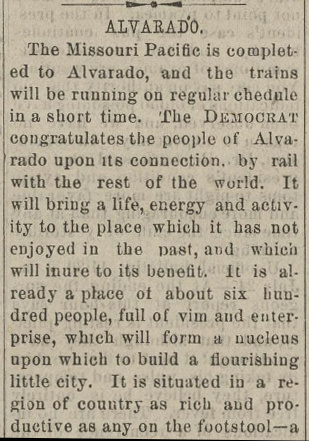 |
Left: The
Fort Worth Daily Democrat of July 26,
1881 celebrated the arrival of the MP tracks into Alvarado. The
announcement of passenger service was published on
August 7th (below left.)
Right: In contrast
to the MP news, the Fort Worth Daily Democrat
of April 19, 1881 had snide commentary on a recent editorial by the
Alvarado Bulletin anticipating the
construction of the CT&MC. This was par for the course;
any railroad associated with Dallas was guaranteed to get bad press in
Fort Worth. The
"Byrd" reference pertains to the recent prior owner of the
Bulletin,
A. J. Byrd. But the CT&MC succeeded, and the Dallas Daily Herald of
December 27, 1881 (below right)
reprinted the Bulletin's greetings to
Dallas that celebrated its arrival.
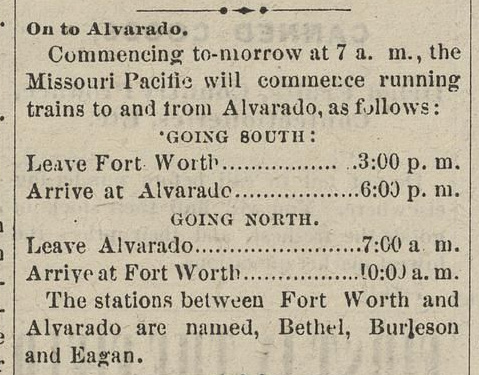
 |
 |
Alvarado had existed for three decades before the
railroads arrived and this affected their right-of-way choices. There were
approximately 400 people in Alvarado in 1880, sufficient population to make
building through the town too expensive for the benefit gained. MP chose a route that passed along the west side of Alvarado and they
built their depot three quarters of a mile southwest of downtown. The location
was inconvenient, but the town did grow out toward the depot. For the CT&MC, the
natural route would have been across the north side of town, but they chose to
make a right angle curve to the south to pass a quarter mile east of downtown,
where they located their depot. The tracks continued south for a short distance,
made a long sweeping curve back to the west, and then angled northwest to cross
the Katy just under a mile southwest of downtown. The crossing was at an acute
angle, about 0.9 miles north of Katy's depot.
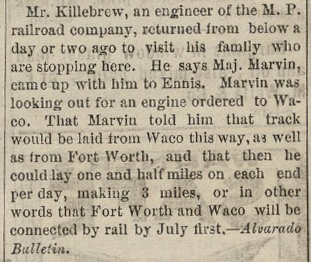 |
The Katy had
obtained access to Fort Worth
under a long term track sharing agreement with the Texas & Pacific
(another Gould railroad) which had built a line from
Sherman in 1880, passing through Whitesboro
to provide a Katy connection.
Thus, it was from Fort Worth that MP initiated the southward
construction of the Katy with the eventual goal of reaching Houston.
Presumably as an act of urgency, MP elected to build in both directions,
southward from Fort Worth and northward from Waco. MP did not have rails
to Waco, but they could ship construction materials and work locomotives
there on the Houston & Texas Central (H&TC) Railroad.
Left:
Fort Worth Daily Democrat, June 7,
1881, reprinting a news item from the Alvarado
Bulletin reporting MP's plan to also build northward from Waco.
Ennis was a major base for the H&TC.
Right:
Fort Worth Daily Democrat, August 2,
1881, reporting that the track-laying north from Waco had reached to
within one and half miles of Alvarado. |
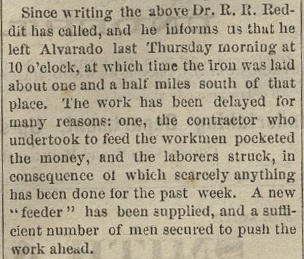 |
In 1901, a new state law gave the Railroad Commission
of Texas (RCT) the authority to mandate safety systems -- interlockers and gates
-- for all grade crossings of two railroads in Texas. The Alvarado crossing was
interlocked on November 21, 1904 when Tower 58 was commissioned for operation.
It was a 20-function mechanical interlocker; twelve was the standard minimum
configuration, so the additional functions most likely pertained to switches and
signals for the exchange track visible in the Barriger photos above. RCT documentation states that the interlocking tower was installed
by the Katy, which also had responsibility for staffing it. Since the crossing
existed prior to 1901, the railroads would have split the capital cost of the
tower and interlocking plant. They would also share the recurring maintenance and
operations costs on a "weighted function" basis. The specific function
definitions are unknown, but the sharing for Tower 58 would likely have been
50/50, or close to it.
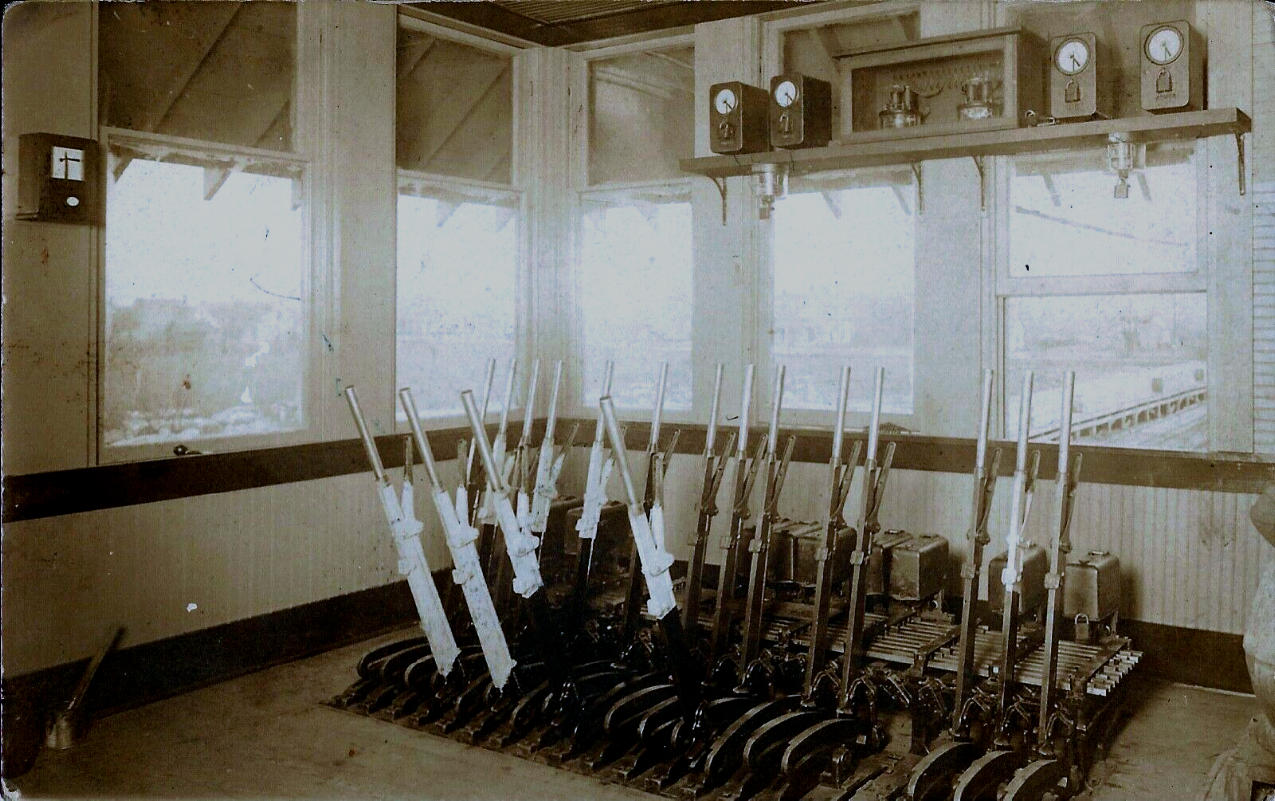
Above: interior view of Tower
58 c.1910 (Dennis Hogan collection)


Above: These historical aerial images ((c)
historicaerials.com) show that Tower 58 appears to have been decommissioned
between 1956 (left)
where it is clearly visible casting a shadow to the north across the Katy
tracks, and 1958 (right) where
it is no longer visible. The tower was replaced by an automatic interlocking.
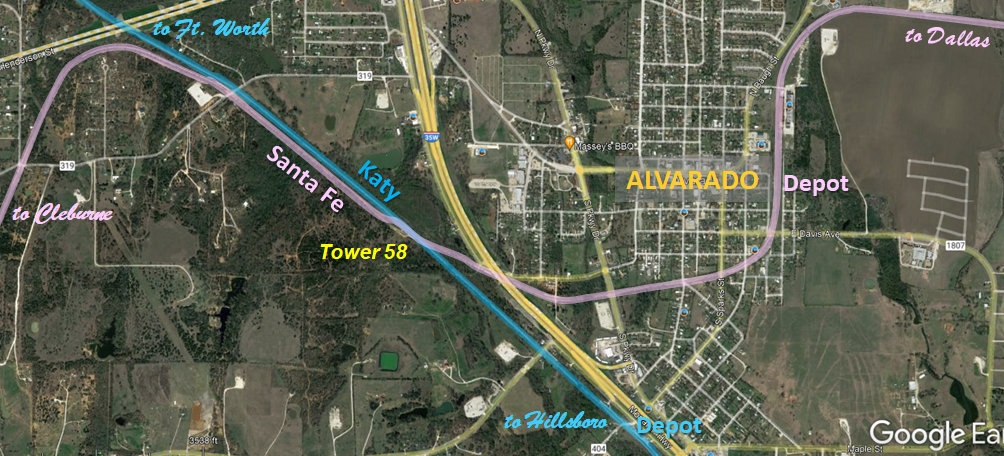
Above: This map
of the vicinity of Alvarado has been annotated to show the rail lines, depots
and Tower 58. Having elected to curve around the south side of town, the CT&MC
could have proceeded west-southwest directly to Cleburne (Cleburne's latitude is
four miles south of Alvarado's.) That they did not do so suggests that the
decision to build the depot near downtown and curve around the south side of
Alvarado may have been made while construction was in progress, making it was easier to return
north and rejoin the planned right-of-way rather than survey a new one and obtain easements for the more direct route. The CT&MC had
no time to waste as they needed to complete fifty miles of track by the end of
1881 to collect a bonus promised by the city of Dallas.
Union Pacific (UP) acquired MP in 1982 but continued to
operate it as a wholly-owned subsidiary. UP then acquired the Katy in 1989 and
merged it into MP. UP acquired Southern Pacific in 1996, less
than a year after Santa Fe had merged with Burlington Northern to create
Burlington Northern Santa Fe (BNSF). Approvals of these mergers resulted in
significant grants of rights between the two systems to ensure competition since
they controlled a huge percentage of Texas rail activity. This appears to have
impacted the crossing at Alvarado, where the diamond was removed in 1996,
replaced by two switches and a short section (~ 100 feet) of shared track. This
gave both railroads the ability to crossover to the other's tracks, allowing
southbound-to-eastbound and northbound-to-westbound movements off of UP's
tracks, and westbound-to-northbound and eastbound-to-southbound movements off of
BNSF's tracks.
Below: The merger-related track changes at the Tower 58
crossing are evident in these images ((c) historicaerials.com) from pre-merger
1981 (left) to post-merger
2016 (right).



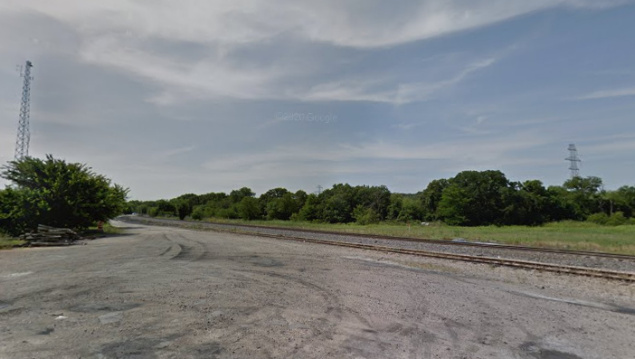
Above Left: Looking north, this is the post-merger track
arrangement at the Tower 58 crossing with UP tracks (left) and BNSF tracks
(right) going south off the bottom of the image. (Jim King photo.)
Above Right: The Katy depot
was located here on the east side of the tracks, just under a mile south of
Tower 58. The date it was removed has not been determined. (Google Street View,
2015) Below: photos of the
Alvarado depots from the H. D. Connor Collection.
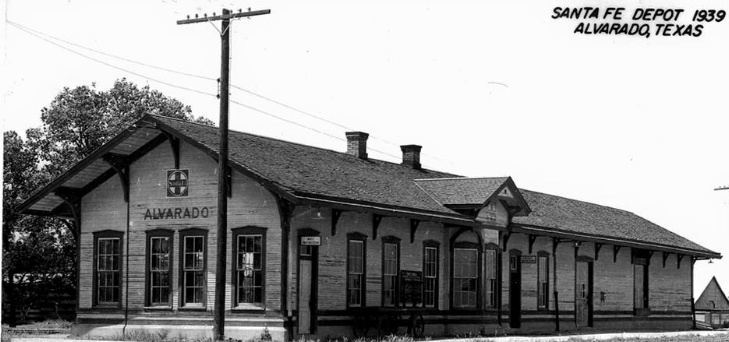

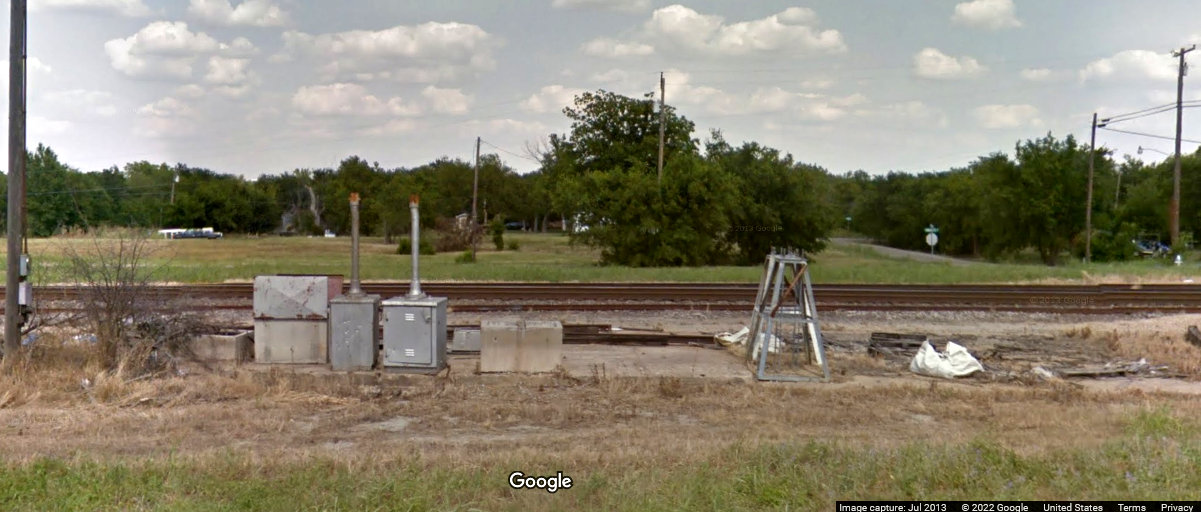
Above: The foundation of the
Santa Fe depot had become a convenient collection spot for assorted railroad
refuse when this Google Street View image was captured in 2013.





















